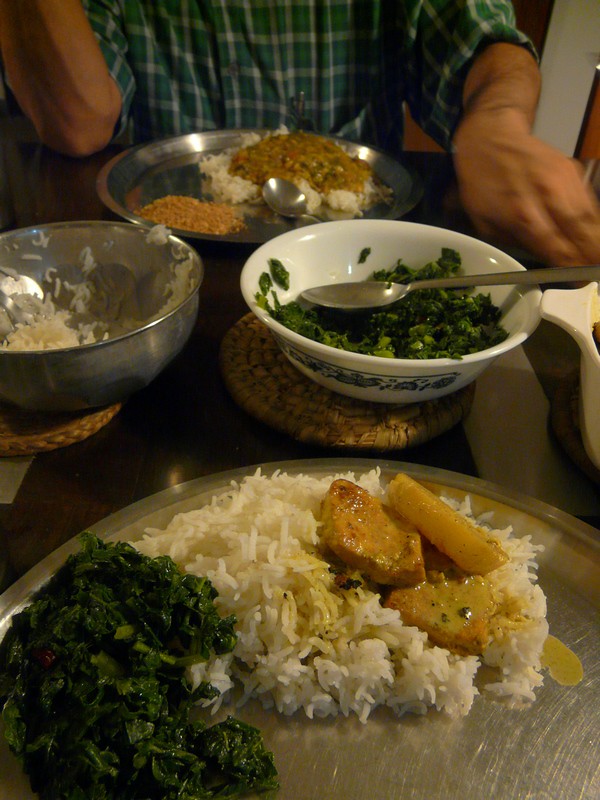Paneer is rigor for a Kashmiri vegetarian spread. Good high-fat milk is hard to come by in mountainous Kashmir since there are no water buffaloes; low fat cow milk is what you get. Despite this, dahi (yoghurt) and paneer are plentiful and a regular part of the diet. On days fasting is prescribed, all Kashmiri Pandits practice vegetarianism; even those who may not be fasting. Observing periodic dietary restrictions are to be found in most faiths and belief systems, be it Ramzan for Muslims, or Lent for Christians. Us Hindus seem rather fond of fasting and have created an immense variety of them. To add to the fun, each fast comes with its own rules: what is kosher, what is not, or the length of the fasting period (half a day to up to an entire month). You may also chose the frequency of fasting: weekly, fortnightly, monthly, or yearly. If you like to walk your own path, well, you could even customise your fasting routine.
Some food preparations are so intricately tied with f(e)asting that it is hard to imagine anyone would cook them on ‘normal’ days! Breaking of a fast with specific foods also brings a special significance to those foods and further intensifies the link between our memories of events and places with the food we eat.
When we were children, my mother observed a few monthly fasts such as on poornima (full-moon day) and ashtami (the eight day of the Hindu lunisolar calendar) in addition to some other prominent annual ones. On these days we would be explicitly instructed to stay out of the kitchen and not touch either the washed cooking vessels, or the freshly prepared food unless we had washed ourselves scrupulously, or until she had eaten. Most of these fasts permit the consumption of fruits, milk, and milk preparations throughout the day. You may also eat one ‘regular’ meal of the usual staples which, in her case consisted of steamed white rice with a couple of vegetarian preparations. She would usually have this meal in the late afternoon, around 3 o’clock or so, after we were fed and calmed from a boisterous day at school. If it was her day off, then she might even have a mid-day snack of potatoes (Phak’e Aulov!) fried in mustard oil. Oh how we would beg her to throw a few into our outstretched hands! She did always share a few.
Tchamam just (tcha-mun cul-e-yah) is one of those utterly simple dishes that delivers on taste on a day when one meal is all that you are going to get. But, it is there on every Kashmiri feasting menu as well! Eating well is not about how much you can eat anyway. Whenever I am craving Kashmiri food and yet do not have much time to spare, this is the dish I turn to. If there is time, then I will make the paneer myself. Using store bought paneer makes it a very quick dish. This mild dish is very unusual in its spicing; green cardamoms and fennel combine with milk for a flavour so subtle you have to eat to believe it can be this good!

Tchamam just
(Paneer in a milky broth)
200 gms paneer
1 medium sized potato, peeled and sliced into 1/4th inch discs (cut into half if the potato is too large) (optional)
3-4 green chillies, slit
1 T saunf (fennel) powder
1/2 t sonth (ginger powder)
1 t coriander powder (optional)
1/2 t turmeric powder
1-2 T mustard oil
hing (asafoetida), pinch
1 clove
2 green cardamoms
1 Tejpatta (Cassia Leaf)
1/4 t masala salt (optional)
1/2 C milk
salt to taste
Cube* the paneer. Take about 3/4 cup of hot water in a bowl. Add the turmeric to the water and keep ready. Pan fry paneer to a light gold. Watch this step; it is very easy to overcook. In this dish, underdone is better than over. If you have good paneer made with full fat milk you can sear the paneer without any oil. Lower the pan fried paneer into the dish of warm water.
Heat mustard oil to smoking. Fry potato slices just till they begin to colour. Remove with a spoon. Add hing to the hot oil. Add the whole spices and stir till fragrant (a few seconds). Turn heat down. Add coriander powder and stir. Add paneer and the soaking water. Add saunth and saunf powders, salt, and the slit chillies. Stir. Add the potatoes, cover, and cook at a simmer till the potatoes are tender (7-10min.) Add milk and simmer another few minutes. Turn heat off, sprinkle the garam masala and stir. Serve with steamed white rice.
 * For ceremonial feasts the he came (Kashmiri cook) always cubes paneer into big chunks (3/4″ cubes) for kaliya which is served from a huge earthen pot that it is cooked in. Home cooks cut the paneer into thick (1/4″ thickness) rectangular pieces (about 1″ x 1 1/2″ or thereabouts) or 1/2″ cubes. It just depends on which way we are inclined on a particular day.
* For ceremonial feasts the he came (Kashmiri cook) always cubes paneer into big chunks (3/4″ cubes) for kaliya which is served from a huge earthen pot that it is cooked in. Home cooks cut the paneer into thick (1/4″ thickness) rectangular pieces (about 1″ x 1 1/2″ or thereabouts) or 1/2″ cubes. It just depends on which way we are inclined on a particular day.
Note: Potatoes are not traditionally added to kaliya. But if you know me then you know how much I love my taters! 🙂 On occasion, though, potatoes are added to many dishes to extend them. Simmered in this milky broth infused with mild spices like cardamom and fennel, the potato absorbs the flavours to present itself in yet another glorious avatar.



